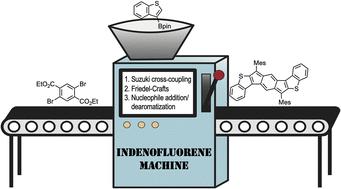二茚二烯和二茚二烯的抗芳性和双自由基性的相互作用
IF 7.4
1区 化学
Q1 CHEMISTRY, MULTIDISCIPLINARY
引用次数: 0
摘要
在过去的15年里,我们的团队进行了多种结构/性质关系研究,以评估逻辑结构改进如何影响抗芳香性/双根碱连续体。利用精密有机合成技术,我们可以改变亲芳核和外熔合芳烃基团的化学组成。通过实验(NMR, CV, UV-Vis, x射线数据)和计算(NICS-XY扫描,NICS2BC,键电流图)确定的合理设计的反芳香diareno-融合s-indacene衍生物导致分子的异性,即HOMO-LUMO能隙的显著变化。在核心基序内的连续交叉点提供了二茚二芳烃结构,其中化合物的副性最小化,但二苯二芳烃特征出现。利用改变外环与芳香碳环和杂环融合的相同技术,创建了一系列结构,其中分子的双自由基特征和单重态-三重态能隙可以以可控的,可预测的方式变化,如实验确定(NMR, CV, UV-Vis, x射线,SQUID数据)和计算使用高级量子化学计算。基于这些基础研究,我们已经证明了二茚二烯和二茚二烯可以作为ofet的活性层,通常表现出双极性电荷特征,空穴迁移率高达7 cm2 V−1 s−1。我们还发现,我们的quinoidal/ diradicaloids化合物在更长的分子长度上具有较大的非典型抗欧姆电导增强,这表明这类有机材料是制造高导电性和可调谐纳米线的有希望的候选者。总的来说,我们的研究表明,传统的物理有机化学概念可以很容易地应用于现代有机材料的研究。本文章由计算机程序翻译,如有差异,请以英文原文为准。

The interplay of antiaromaticity and diradical character in diarenoindacenes and diindenoarenes
Over the past ∼15 years our group has performed multiple structure/properties relationship studies to assess how logical structural refinement can affect the antiaromaticity/diradicaloid continuum. Using precision organic synthesis, we can alter the chemical composition of both the pro-aromatic core and the outer fused arene groups. The rational design of antiaromatic diareno-fused s-indacene derivatives leads to pronounced variation of molecule paratropicity, i.e., the HOMO–LUMO energy gap, as determined experimentally (NMR, CV, UV-Vis, X-ray data) and computationally (NICS-XY scans, NICS2BC, bond current plots). Successive benzinterposition within the core motif affords diindenoarene structures where compound paratropicity is minimized yet diradicaloid character emerges. Using the same techniques of changing outer ring fusion with aromatic carbocycles and heterocycles created a series of structures where the diradical character and thus the singlet–triplet energy gap of the molecule could be varied in a controlled, predictable manner, as determined experimentally (NMR, CV, UV-Vis, X-ray, SQUID data) and computationally using high-level quantum chemical calculations. Arising from these fundamental studies, we have demonstrated that diarenoindacenes and diindenoarenes can act as the active layer in OFETs, often showing ambipolar charge characteristics with hole mobilities as high as 7 cm2 V−1 s−1. We also established that our quinoidal/diradicaloid compounds possess large, atypical anti-ohmic conductance enhancement of their transport properties at longer molecular lengths, which suggests that this class of organic materials is a promising candidate for creating highly conductive and tunable nanoscale wires. Taken as a whole, our studies show that traditional physical organic chemistry concepts can be readily applied to modern organic materials research.
求助全文
通过发布文献求助,成功后即可免费获取论文全文。
去求助
来源期刊

Chemical Science
CHEMISTRY, MULTIDISCIPLINARY-
CiteScore
14.40
自引率
4.80%
发文量
1352
审稿时长
2.1 months
期刊介绍:
Chemical Science is a journal that encompasses various disciplines within the chemical sciences. Its scope includes publishing ground-breaking research with significant implications for its respective field, as well as appealing to a wider audience in related areas. To be considered for publication, articles must showcase innovative and original advances in their field of study and be presented in a manner that is understandable to scientists from diverse backgrounds. However, the journal generally does not publish highly specialized research.
 求助内容:
求助内容: 应助结果提醒方式:
应助结果提醒方式:


